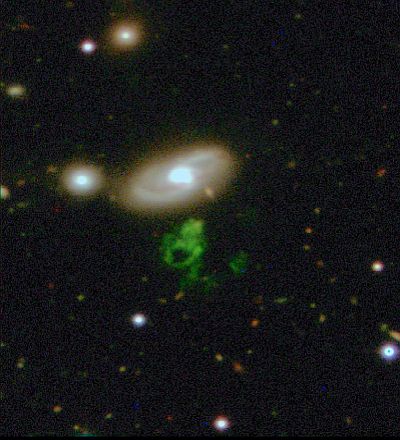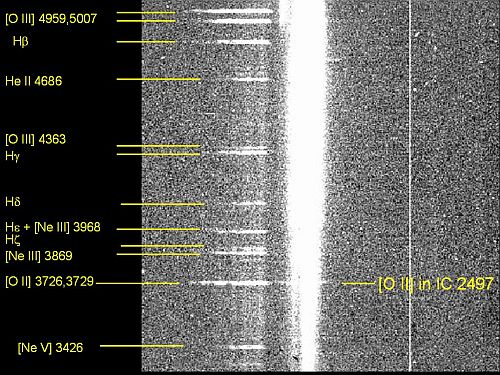 | |||
|
| Home > Public Information > Scientific Highlights > 2008 > The Galaxy Zoo and Hanny's Voorwerp |
The Galaxy Zoo and Hanny's VoorwerpWHT+PFIP, WHT+ISIS, INT+WFC
Galaxy Zoo (GZ) is a online project in which volunteers visually classify the morphologies of galaxies selected at random from the spectroscopic sample of the Sloan Digital Sky Survey Data Release 6 (DR6). Information of this type is essential to
the development of our understanding of galaxy formation. The public response to the launch of GZ in 2007 July was overwhelming, achieving over 36 Myr classifications within a few months and results that agree exceptionally well with those of professional
astronomers. To make the project accessible to as many people as possible a relatively simple classification scheme was used.
Once launched, the Galaxy Zoo website quickly attracted an avalanche of attention from the public and media alike. A story about it on the BBC News website quickly became one of the most e-mailed stories of that day and the initial traffic was such that it temporarily brought the Galaxy Zoo server down. They were quickly back online and gaining traffic of over 70,000 classifications an hour. This meant that the million hits that the team initially hoped for were achieved in a matter of days. By the end of November 2007 every galaxy in the sample had been observed by on average 40 people; a signal-to-noise ratio that the team had only dreamed of achieving. Some individual objects have also gained a lot of attention; the most famous of these is the Voorwerp (the Dutch for “object”), which was discovered by Dutch schoolteacher Hanny van Arkle. Observations with the William Herschel, among others, led astronomers to the conclusion that this object consists of highly ionized gas.
With no obvious source of ionization present in the Voorwerp, or in the neighbouring galaxy, they believe that it must come from a light-echo — the reflection of the light from an active nucleus in the Voorwerp’s companion galaxy more than 40,000 years ago. If they are correct, then reflections from different parts of the Voorwerp record the behaviour of the black hole at different times, so the history of the black hole’s shutdown is laid out on the sky for astronomers to see.
The spectrum shows emission lines typical of star-forming regions spread across the object, at a redshift associating it with IC 2497, but shows, in addition, features indicating unusually high temperature and higher ionization than seen in H II regions. To have the [O III] 4363 line detectable, the gas has to be unusually hot, more like 15-20,000 K. He II is produced when an electron joins a bare helium nucleus, and requires high enough temperature or radiation with enough energy to tear both electrons from helium. We don't see this in star-forming regions. The only stars hot enough to produce He II in surrounding nebulae are the central stars of planetary nebulae, which are the hottest stars known, but only for a few thousand years, and a handful of X-ray-bright stars usually associated with accretion onto black holes or neutron stars. On top of that, at the blue end of the spectrum is [Ne V]. Pulling four electrons from neon requires 97 electron volts (eV), compared to 54 to make He II and 13.6 to ionize hydrogen. [Ne V] does sometimes show up in planetary nebulae, but even there calculations suggest that it's not the UV starlight that's responsible, but that high-speed shock waves may be the culprit. This line is also common in the spectra of active galaxies - Seyfert nuclei and their kin, where we know that there are abundant X-rays interacting with the gas. The high ionization might suggest shock ionization or photoionization by an active galactic nuclei, which would have to be much brighter than any we see in the neighborhood. If the AGN is in IC 2497, it must be highly obscured from our direction but not toward the gas. It may be significant that the cloud lies near the galaxy's projected minor axis. Whatever it is, it seems to be quite unique in the SDSS imaging survey. More information:
|
| Top | Back |
|



